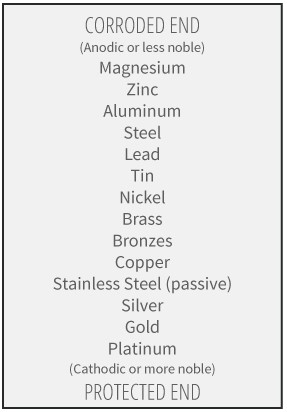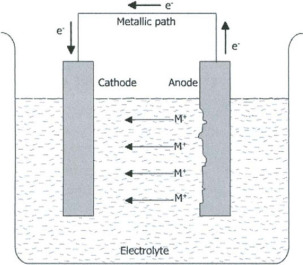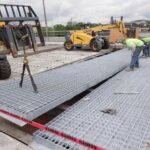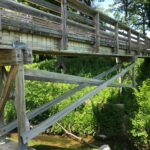When it comes to bridge engineering, the devil is in the detail. A problem at first glance looks like a simple one to solve – in engineering this is usually related as capacity must be greater than the demand. But there is more to most design problems than answering the question is it strong enough. Strength in the modern sense is how much load will it take to break it. But often times we are more concerned with the day to day service aspects. Is it stiff enough? Are the service level stresses going to be detrimental to service life?
One serviceability aspect that is often overlooked is the concept of corrosion induced damage. For the majority of work done in the heavy civil or structural world we mainly consider two types of material – concrete and steel. These two materials work well together, like Butch and Sundance. Concrete is strong in compression while steel is strong in tension. By combining forces, reinforced concrete has the best properties of both. However, steel has other weaknesses that it is keeping from its partner – it can fracture under cyclic loading below its yield strength, a phenomenon known as fatigue. And it is also subject to corrosion if left exposed to the environment.
Concrete helps protect the steel from corroding by providing a barrier against the oxidizing environment. But concrete is porous and won’t be able to protect the steel forever. In marine applications or where salt brine or other deicing chemicals are used, chloride and other anions begin to penetrate into the pores of the concrete. While this process is inevitable, it can be delayed a long time, possibly for the life of the component, by taking the time to look at the details.

Concrete clear cover – this is the thickness of concrete placed over the embedded steel – can be increased to help delay the contact between the anions and the steel. Concrete coatings can be applied to prevent chloride penetration. In aggressive environments where the cover would need to be increased excessively, a non-reactive barrier may be placed over the steel. Epoxy paints are applied in many applications and are used in bridge decks in many states such as Washington. Sacrificial barriers can also be employed, such as using a zinc coating on the steel. Or you can use a type of steel that won’t corrode at all in the presence of anions, stainless steel.
There are many types of corrosion resistant reinforcement on the market today. Stainless steel is the first to come to mind, but it is expensive – about 4 times the cost of conventional reinforcement. Epoxy coated reinforcement is widely used and is only about 10% to 20% more than uncoated steel. MMFX or ChromX is available. Available with three levels of chromium content to make it corrosion resistant, this stuff is also available in higher strength grades (100 ksi and 120 ksi) which can help offset the cost. The middle grade chromium content ChromX is comparable in cost to epoxy coated reinforcement.
GFRP and galvanized reinforcement are also out there. GFRP has no iron in it so it doesn’t corrode at all. It is also non-conductive, which helps with stray current issues on transit structures (see below). Galvanized reinforcement relies on tried and tested principles of protecting steel with a less noble sacrificial coating of zinc.
In most structures, you’re only worried about protecting your steel from the environment. Oxygen and water. Keep it dry in a bottle of oxygen and you are good. Keep it wet and in space, you are good too. Neither of these is realistic, so you find a way to protect it. Painting steel is one way, galvanizing it is another.
But what happens when you have to use other more exotic materials in your designs? Many pedestrian rails are made from aluminum alloy. Other components are made from aluminum because it weighs less than steel. But think of aluminum as your slightly odd, rather sickly friend. A nice guy with some good qualities, but sometimes rather tedious to deal with.
Dissimilar metals, also known as galvanic corrosion, can be a real problem. When two different metals come into contact inside of an electrolyte, one metal will act as an anode and one metal will act as a cathode. Like a battery on your car, the electrons from the anodic metal will travel towards the cathodic metal. And when electrons move it means material is moving. That material is your anodic metal being “eaten” away!

There is a hierarchy known as the galvanic series of metals. Electrons tend to move from the top of this list down, going from less noble metals to more noble metals. Zinc and aluminum are more anodic metals while gold and platinum are more cathodic. Metals that are closer together on the galvanic series are less reactive, that is the potential between them is less and thus they tend to be less reactive when brought into contact.
Without an electrolyte, there can be no galvanic corrosion. So if you are contacting aluminum and stainless steel in a dry environment, worry not and carry on. However, in the bridge world our structures are always exposed to the elements and are soaked in electrolyte.
When aluminum alloys are specified for use, contact with regular carbon steel is generally acceptable since their reactivity is low due to their positions on the galvanic series. However, contact with concrete should be avoided. Aluminum and the alkalis in concrete react to create hydrogen gas and aluminum oxide. Aluminum is extremely reactive with stainless steel, which can cause pitting and corrosion if left in direct contact.
Both aluminum and stainless steel are great for use in marine environments since they are generally unaffected by exposure to chlorides. However, these two are distinct enemies that must be kept apart. Where aluminum assemblies are mated to stainless steel parts, gaskets or barriers are often used to keep these two apart. Aluminum assembles are often held in place by stainless steel fasteners. To prevent a reaction, isolation bushings are used to prevent contact between the fastener and the aluminum.
Galvanic corrosion is often seen as a detrimental side effect, but it can also be helpful in certain circumstances. Cathodic protection is one such example. There are two main types of cathodic protection – passive and impressed current.

On your boat, you have many examples of passive cathodic protection. Zinc anodes are attached to the more vital parts of your boat to create a reaction between the less noble zinc and the steel or stainless steel of your boat. As the zinc is less noble than the steel, the zinc is “sacrificed” and it slowly dissolves away. In this way, you are protecting the cathode in this system – your propeller, your boat shaft, your rudder, etc. Make sure you replace your anodes periodically!
The current produced by the reaction of a passive anode and the parts of your boat is quite small. This is generally acceptable for small systems, but in larger systems the voltage causing the corrosion is larger than the galvanic system alone. To solve this problem, impressed current cathodic protection is used. Current is externally applied and regulated to counteract the natural current causing the damaging corrosion.
Stray current that enters the galvanic system can actually accelerate corrosion if not checked. By entering the system unintentionally, the added current can sometimes overwhelm the system and negate the effectiveness of the cathodic protection. Impressed current systems help control this, especially if the stray current was not initially anticipated. Transit bridges will often ensure that separate grounding systems are in place to prevent harm from stray current in addition to proper isolation of the running system from the structure.
So there you have it, small details are important. And while small details often don’t jeopardize strength, they can often jeopardize other things like the service life of a component. Not properly zincing your boat won’t affect your motor’s ability to run in the short term, but you’ll be going through an awful lot of propellers. Proper attention to these things is important, both by engineers and by those maintaining our structures if we want our transportation dollars to go further.
Views: 2211







Hi there! I’m at work browsing your blog from my new iphone 3gs! Just wanted to say I love reading your blog and look forward to all your posts! Carry on the superb work!|
It’s a shame you don’t have a donate button! I’d definitely donate to this excellent blog! I guess for now i’ll settle for bookmarking and adding your RSS feed to my Google account. I look forward to new updates and will share this website with my Facebook group. Chat soon!
Hey There. I found your blog using msn. This is a really well written article. I will be sure to bookmark it and come back to read more of your useful info. Thanks for the post. I抣l definitely comeback.